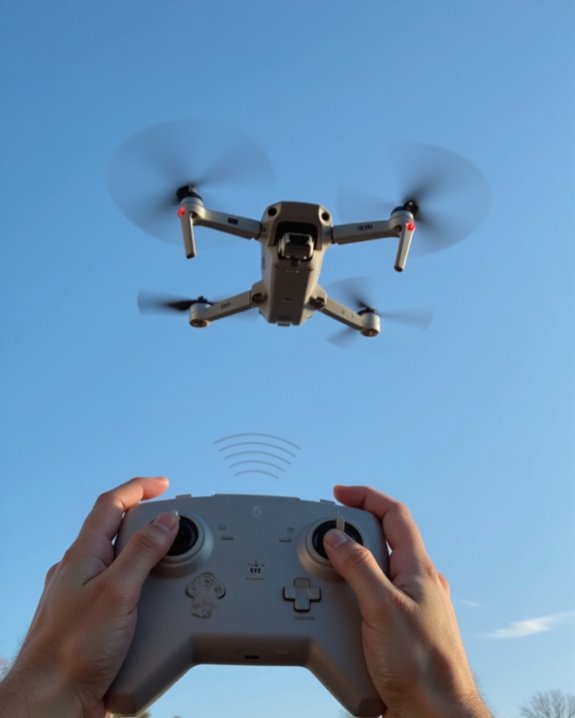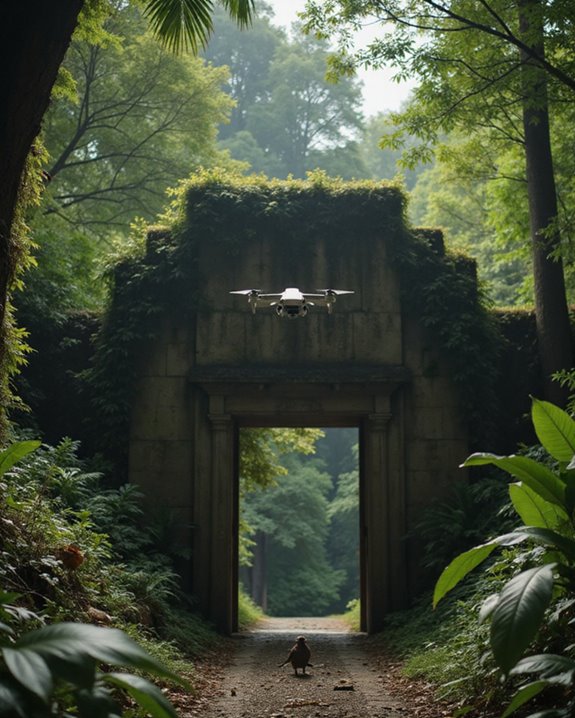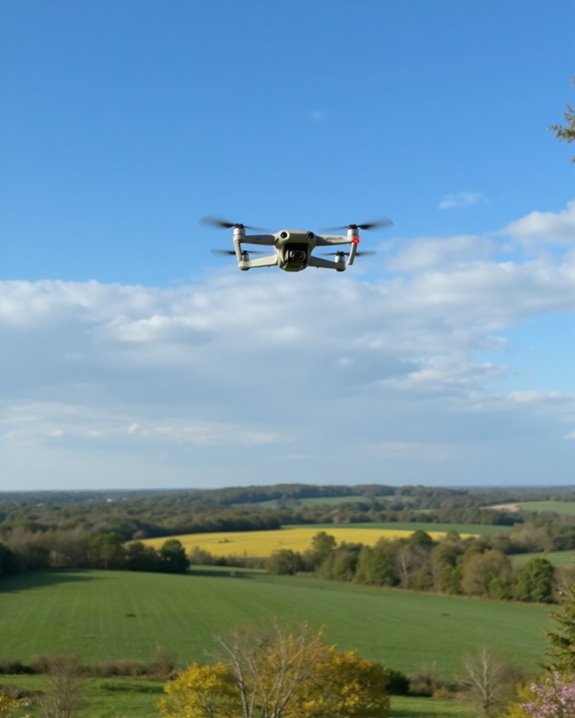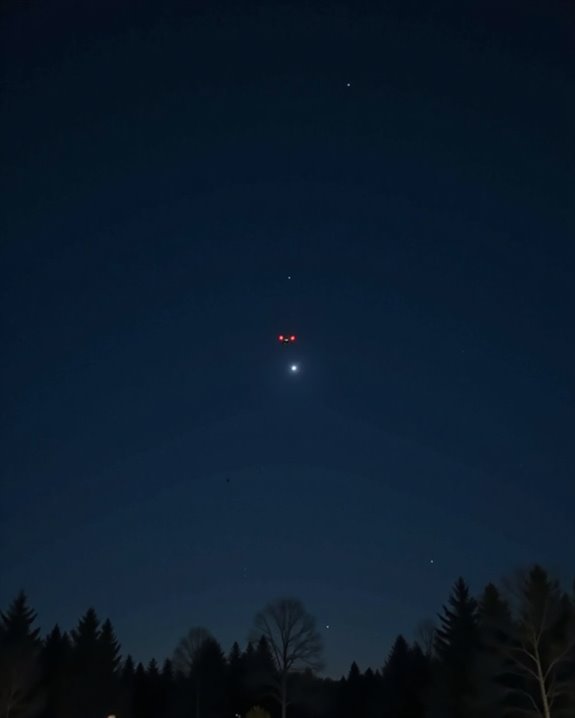To control a drone with radio signals, a person uses a transmitter—basically a fancy joystick loaded with buttons and switches—that sends commands through invisible radio waves, typically at 2.4 GHz, to a receiver on the drone. The drone instantly reacts, moving, turning, or hovering just as commanded, thanks to real-time signal processing and smart antennas. Weather or tall trees might try to foil your fun, but modern interference management keeps the adventure going! Want to uncover more of the magic behind drone flight?
Key Takeaways
- A transmitter sends digital commands as radio signals, typically using 2.4 GHz frequency, to the drone’s receiver for real-time control.
- Proper antenna alignment and polarization are crucial to maintain strong, interference-free signal communication between controller and drone.
- Receivers onboard the drone decode signals and relay instructions to motors, sensors, and payload systems for responsive operation.
- Advanced signal processing methods, like frequency hopping and wavelet denoising, help prevent interference and ensure reliable control.
- Pre-flight checks and adherence to FAA safety protocols, including maintaining visual line of sight, are essential for safe radio-controlled drone operation.
Core Principles of Drone Control With Radio Signals
When you imagine controlling a drone, it might seem like magic, but there’s actually a whole science behind those smooth flights and sharp turns! Every button you press gets transformed into digital signals, which are then modulated onto radio waves. These signals travel through the air, but not without some quirks—Polarization Effects can make a big difference. If the transmitter and receiver antennas aren’t aligned, signals may weaken, causing your drone to wobble or lag. Propagation Factors, such as trees, buildings, or even rain, can throw obstacles in the signal’s path, making communication a real adventure! Drones rely on special frequencies like 2.4 GHz to perform well, and real-time processing guarantees every command arrives on time. It’s precise, technical, and surprisingly fascinating! However, due to legal restrictions on jamming devices, civilian users must rely on alternative methods like RF-blocking products for signal protection.
Overview of Radio Communication Technologies in Drones
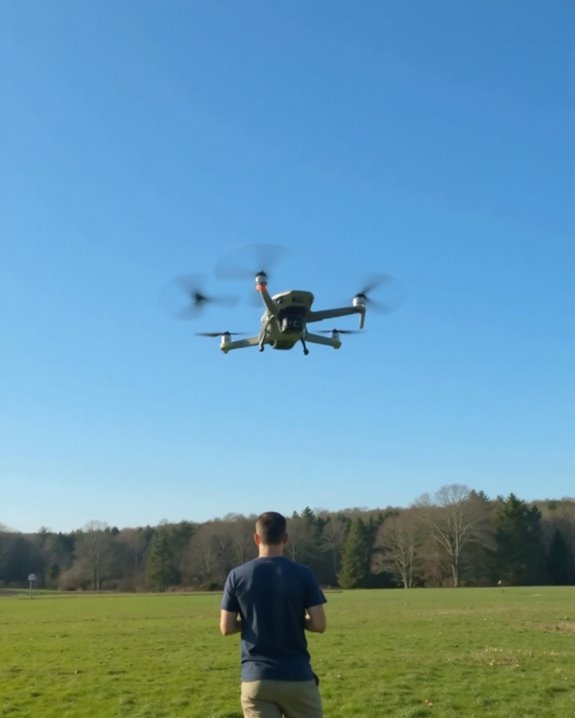
Every drone pilot knows the thrill of sending out a command and watching their drone respond instantly, but have you ever wondered how that magic actually happens? It’s all thanks to radio communication technologies, which have come a long way with Tech Evolution and today’s Market Trends. Most drones use radio frequency (RF) systems operating on high or ultra-high frequency bands—think of them as invisible highways for your drone’s orders! Commercial RF systems, wireless datalinks, and even cellular networks like 4G and 5G are making waves. Satellite communications sound fancy but are usually bulky and expensive, more suited for James Bond missions. With advances like Software Defined Radios (SDRs) and Ethernet radio systems, drones now enjoy more flexible, reliable, and scalable connections than ever before. Modern radio controllers such as the RadioMaster TX16S MKII enhance drone control with advanced multi-protocol support for diverse drone applications.
Essential Components of a Drone Radio Control System
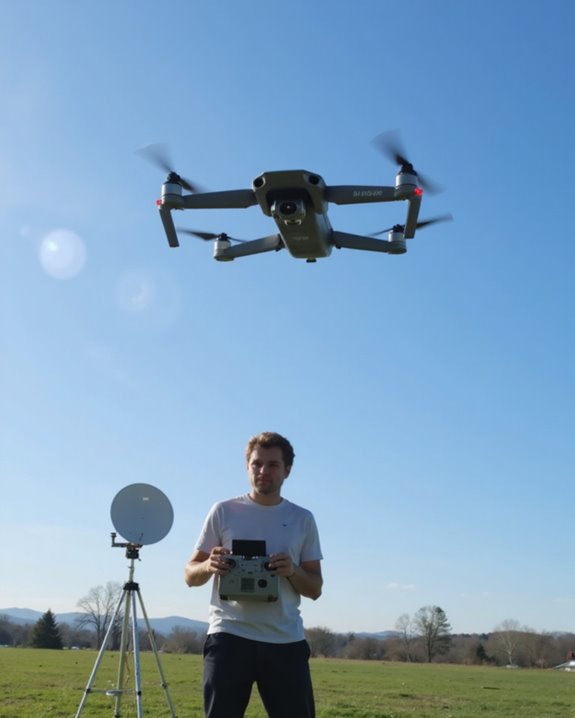
A reliable drone radio control system is like the brain and nervous system working together, making sure your commands actually reach that buzzing wonder in the sky. At the heart of this system are transmitters (your remote control) and receivers, which listen closely and relay every instruction to the drone’s motors and sensors. The magic happens on frequencies like 2.4 GHz, giving you great range and reliability. Antenna systems boost your signal’s strength, while data management hardware keeps communication smooth and fast. Smart Frame Integration is essential—each radio component must fit perfectly within the drone’s frame to avoid tangles and interference. Don’t forget Weight Balancing; careful placement of parts keeps your drone stable, so it doesn’t wobble like a confused duck mid-air! Advanced transmitters, such as the Radiolink T12D with its 2.5-mile range, greatly enhance control distance and responsiveness for more complex flying tasks.
Signal Processing and Interference Management

Getting all the drone’s radio parts in perfect balance is only half the story—next comes the real challenge: making sure those signals don’t get lost in a sea of static or grabbed by pesky interference! Signal processing jumps in here, using tricks like Wavelet Denoising to pull clean drone commands from noisy backgrounds. Imagine a drone flying through a city—so many radio waves! Frequency hopping, compressed sensing, and time-frequency analysis help sort out what’s important. For those tough cases, neural classification steps up, using deep learning to tell drone signals apart from random chatter. Direction of Arrival estimation, combined with switched receiver systems, lets drones listen more carefully and ignore distractions. Real-time spectrum analysis and array processing keep everything sharp, so signals reach the drone loud and clear!
Enhancing Performance and Features Through Radio Control
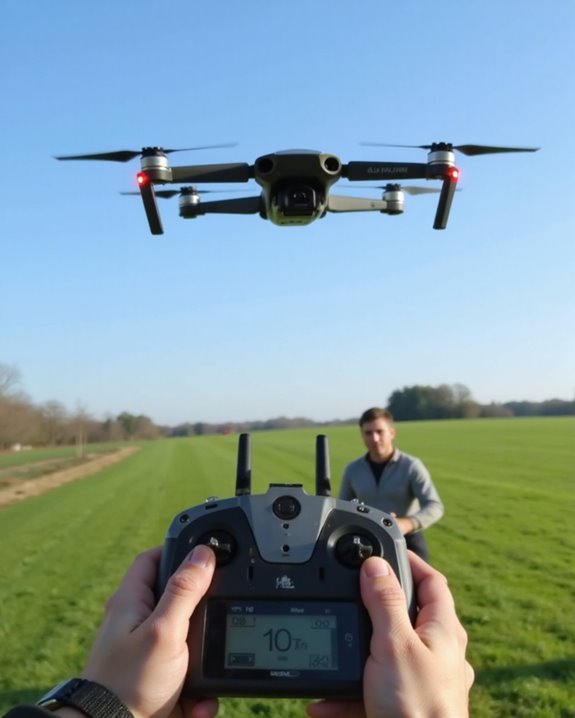
Radio control is the beating heart of modern drone magic, taking flying machines far beyond simple remote-control toys. Advanced radio systems now let drones perform jaw-dropping feats, from real-time aerial photography to precision crop spraying—seriously, who knew plants loved bandwidth? Swarm Coordination lets fleets of drones work together, scanning disaster zones or mapping huge farms faster than a single drone ever could. With Payload Integration, operators can swap between thermal cameras, sensors, or delivery boxes, all thanks to stable radio links on busy 2.4 and 5 GHz bands. Imagine a rescue team getting live video as a drone zigzags through rubble! Fast data speeds, reliable navigation, and intelligent automation mean radio control isn’t just about flying—it’s about unveiling a world of possibilities.
Safety Protocols and Regulatory Compliance in Radio-Controlled Drone Operations
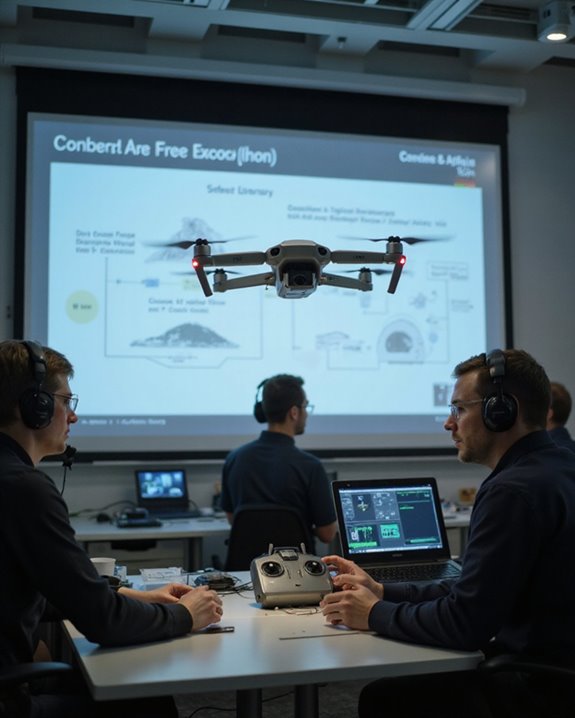
Ever wonder what keeps the skies safe when drones are zipping overhead? The answer is a mix of strict regulatory compliance and thorough safety training! In the U.S., the FAA sets the ground rules—commercial pilots need a Remote Pilot Certificate under Part 107, while recreational flyers obey community guidelines. Remote ID is now a must for most drone flights, so you can’t just vanish into the clouds! Pre-flight checks are serious business: pilots inspect batteries, wiring, motors, and propellers, making sure nothing’s loose or faulty. Everyone must fly below 400 feet and always keep drones within visual line of sight. Flying over crowds, near airports, or while under the influence? Absolutely not! These protocols help everyone share the skies—safely and responsibly.
Frequently Asked Questions
How Long Does It Take to Learn to Fly a Drone With Radio Controls?
The learning curve for flying a drone with radio controls typically spans 8 to 12 hours of practice sessions for basic competence. Individual progress varies, but consistent practice and gradual skill development are essential for achieving reliable flight proficiency.
What Maintenance Does a Radio Transmitter Require for Optimal Performance?
Ironically, neglect guarantees a transmitter’s swift demise. Routine maintenance demands battery replacement before failure, meticulous antenna inspection for cracks, cleaning with compressed air, firmware updates, calibration checks, and careful storage—tasks that, though tedious, guarantee flawless, uninterrupted performance.
Can Multiple Drones Be Controlled Simultaneously With One Transmitter?
Controlling multiple drones simultaneously with one transmitter faces challenges, primarily due to frequency sharing and signal interference. Standard transmitters are typically limited to one drone, while specialized systems or software are required for reliable, coordinated multi-drone operations.
Are Smartphone Apps as Reliable as Traditional Radio Controllers for Drones?
While smartphone apps offer a modern convenience, they may gently underperform compared to traditional radio controllers due to app latency and security concerns. Traditional controllers typically provide more dependable connections, superior range, and stable operation for drone enthusiasts.
How Do Weather Conditions Affect Radio-Controlled Drone Operation?
Weather conditions substantially impact drone operation; wind effects destabilize flight, causing erratic movements and increased crash risk, while rain interference can damage electronics, disrupt sensor accuracy, and reduce data quality, compromising both flight stability and mission success.

